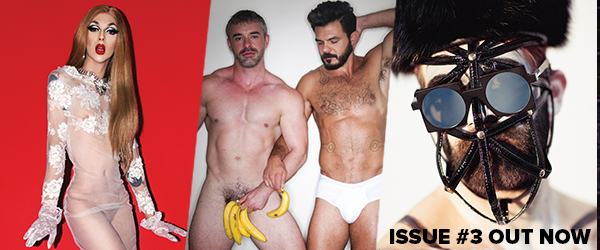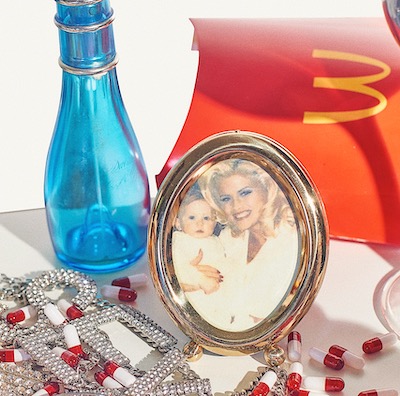
You cannot buy all of Steven Harwick’s art, but you can experience it. When he is not editing Bound Leather zine or producing glossy fashion shoots, Harwick transports himself into an uncanny world of strange and familiar conundrums. Peeling back cursory and superficial layers, his art exposes a more truthful, compassionate exploration of camp.
Harwick is a NYC-based artist who produces material encounters by staging immersive installations that chronicle moments in time or history using assemblage. One does not know what furniture, sculpture, or mere curation is when viewing his installations. Whether it is capturing the sensibility of an emo kid living in his parent’s basement—amped on monster energy while listening to nü metal— to the last days of Anna Nicole Smith in her hotel room at the Hard Rock Hotel, his installations recast elements of “low culture” into illuminating psychological expositions.
That Korn CD and unopened stack of Playboy magazines? Possible evidence of a closeted youth grappling with masculinity.
In his latest installation, Steven recreates Anna Nicole Smith’s bed stand the night she died at the Hard Rock Hotel in Seminole, Florida for the group show “Hollywood Forever,” featuring Elspeth Walker, Alissa Bennett, and Heinzfeller Nileisist Imprints. The show is centered on Alissa Bennett’s book, Dead is Better (NYC, 2016) about mysterious celebrity deaths.
Using pill bottles, pieces of jewelry, old tabloid magazines, “Seminole Hard Rock Hotel & Casino, Room 607” and “For Daniel” forges a new human relationship with Anna Nicole Smith, whose death symbolizes a bygone era of unearthed feminist consciousness. We are talking about the days when the pop culture hive mind hardly analyzed sexism and misogyny, and women like Anna Nicole Smith were seen as “trashy” or “dumb” as opposed to empowering and authentic. Harwick intends to convey the truth about her trauma. He hopes the viewer can realize the aftermath of celebrity or at least perceive Anna in a more empathetic manner.
Why the bed stand? It is an object with collective significance and provides a glimpse into one’s welfare. Like Tracey Emin’s “My Bed,” “Seminole Hard Rock Hotel & Casino, Room 607” reveals the mental anguish and physical pain she endured right before her death— aspects often ignored or weaponized. By developing a piece that deals with medication, depression, and pain within a gallery setting, Harwick is universalizing mental health struggles. Even a rich, gorgeous blonde bombshell like Anna Nicole Smith suffers.
We interviewed Steven about the trajectory of his art. Both past and present, and how reappraising figures such as Anna Nicole Smith creates a more inclusive, tolerant society.
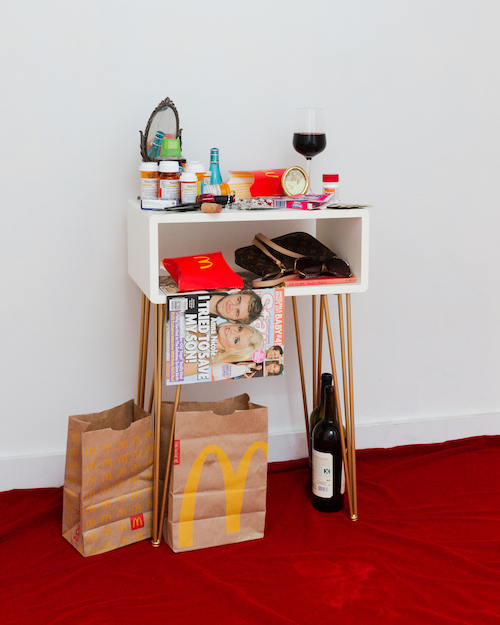
When did you start making sculptures, installation, and assemblage?
I suppose the catalyst of making work like this for me was in creating sets and things for my still photographic work. I studied photography at Pratt and my junior/senior year projects were focused on subverting portraiture that could have been authentic to the 1950s and 60s. I would really enjoy the hunt of sourcing the perfect items to set the scene for these photographs – period-specific clothing, sheets, ashtrays, cigarettes, etc. At some point, I thought of the experience of being in the space itself rather than simply experiencing the photograph made in the space. I enjoy both avenues of producing work, but when given the opportunity and the space, there is something really exciting for me about getting to really put viewers in tangible space, able to smell, hear, etc. And I like it shown in conjunction with still images even – as if the imagined world spilled over into reality.
How do you choose your references and which “worlds” to exhibit?
That’s when I get to put my curator pants on… despite the fact that most of these installation pieces are ‘imagined’ spaces, they are definitely rooted in reality. I get to put myself in the headspace of the person whose room I am trying to create and think about what could visually serve as signifiers for who they are. For example with ‘Bred in Captivity, 2006’, shown at 182 Avenue C in their show Half Life, I was very much thinking about basements of boys I knew growing up. I used my personal CD collection that I still had from when I was younger and found other items and objects to add to that conversation (Abercrombie & Fitch cologne bottles, Monster energy posters, comic books, etc.). In terms of ‘Seminole Hard Rock Hotel & Casino, Room 607’, there are no public crime scene photos, per se. But I remember seeing TMZ photos of the contents of the refrigerator in the hotel room Anna Nicole Smith died in – stocked with methadone and Slim-Fast. I guess I am just so deeply like an object fetishist and think what a person touches has so much power and what a person chooses to surround themselves with is intrinsically important to who they are as people. When thinking about creating an imagined bed side table for Anna Nicole’s final Hard Rock hotel room, I just thought about what this woman, still grieving the loss of her son less than 5 months prior to her own death, would have with her for her trip to Hollywood, Florida.
It seems like korn and monster energy drinks are peaking or maybe just had its post-ironic peak.
I think there is definitely an aesthetic revival of mid-aughts sensibilities – nu metal and energy drinks of course being a part of that. Personally, I attribute this to the fact that it’s the last generation to exist on the cusp of technology. And I see it’s resurgence as twofold: one being people my age who grew up in it, reclaiming these childhood things in a flurry of nostalgia, and the second being Gen Z kids who were babies during this time, but still somehow feel this ping of nostalgia for Y2K-era fashion and technology, despite most of them growing up 100% on the Internet. Either way or regardless of the reason, I love seeing the colors, textures, and vibes of this era being referenced in the pop culture of today.
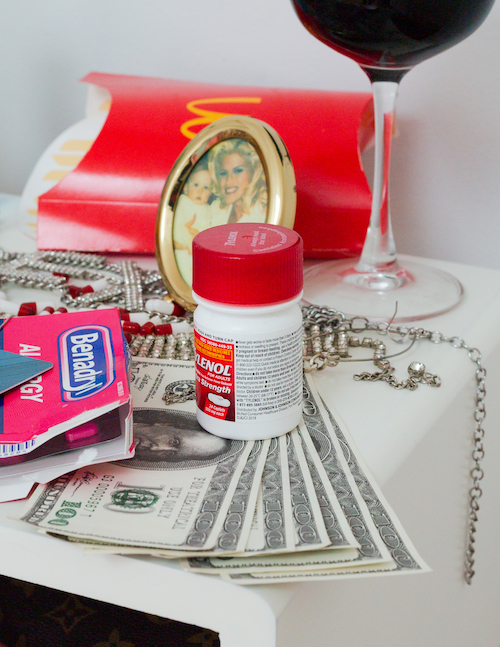
“Seminole Hard Rock Hotel & Casino, Room 607,” which is about Anna Nicole Smith’s last days is another world you explore. Of all the celebrities who died in the last twenty years, hers is especially bleak considering the life she led and her son’s death. To tackle such a dark matter seems daunting. Why Anna?
I have always been drawn to Anna Nicole – from the first time I ever saw or heard anything about her. I think, you know, the usual – she was strikingly beautiful and had such a personality. But beyond that, I remember knowing that how people were talking about her was criminal. She always felt like an underdog to me, even when she ostensibly had everything she could ever want, because no one was rooting for her. And there she was – this imperfect goddess – at the genesis of reality television. And really not shying away from the reality of any of it – but indulging it and rubbing our faces in it. I was enamored by her – she was an enigma, far smarter than she let on. A true artist. And her death, despite being such a dark subject matter, was made for public consumption and directly impacted me. I wanted to honor her – not have her be the butt of the joke. She is a legacy deserving of preservation, while also not shying away from reality – and being as shamelessly honest as she was in life.
There is definitely something rather universal and even connected to the pandemic, especially all the references to psychiatric medications. Did the events from the last year and half impact your practice or mindset as an artist regarding this piece?
For me as an artist during this time, I was just trying to figure out an artistic practice that I could do while isolated. Mainly working as a photographer, so dependent on a subject in the room with you, my focus had to shift a bit and this solitary activity of research, binge watching, sourcing materials, and finally putting / staging the installation was a nice escape from the need to be with anyone else. It was a piece that I was able to live with and around and take my time with and just find the right objects to include. In terms of this piece, or Anna’s life in particular thinking about this year, I was thinking about all of the people suffering in silence be it with substance issues, mental health issues, etc. – while COVID was the focus of the year, other illnesses definitely fell by the wayside in terms of availability of resources. As a sober person who owes my sobriety to mental health and substance abuse resources as well as 12-step meetings, this year was challenging with so many of those things changing drastically or disappearing altogether. I think about Anna, who despite having people ostensibly on her side, and monetary resources at the disposal, still succumbing to accidental death.
Do you have any favorite moments from Anna Nicole Smith that helped you shape or frame this installation?
I still watch clips from her show and live appearances on YouTube regularly. She had amazing one-liners. I think what struck me about her was her openness and humor. There are literally far too many to name. But I definitely gravitate towards moments where she was in on the joke rather than moments that were publicized and blown up because they were making fun of her.
Like Alissa, I think your piece works to recontextualize her life and death. It makes me think of the saying “Trash is beautiful.” Ana was beautiful trash. Is that an intention per se, To rewrite the history of Anna Nicole Smith?
She did so much and gave us so much. She was at the forefront of reality TV, pre-social media, and was brilliant in curating her persona to feed to the public the way she wanted to. It was so calculated and genius. She was so smart. But I think she is a cautionary tale in the ways of the press and media – even if you give them everything and try to curate what your output is, things still can be taken out of context or blown up – or not – and people will still form opinions about you. The public ideas that circulated were that she was a gold digger, and the epitome of a dumb blonde. I just hope the pieces humanize her and – what I took away from creating the work, that I hope others take away from viewing it – was just the sheer amount of substances she was taking. Legal and prescribed substances. But just a lot of mixing and realizing fame is not a shield against that accident.
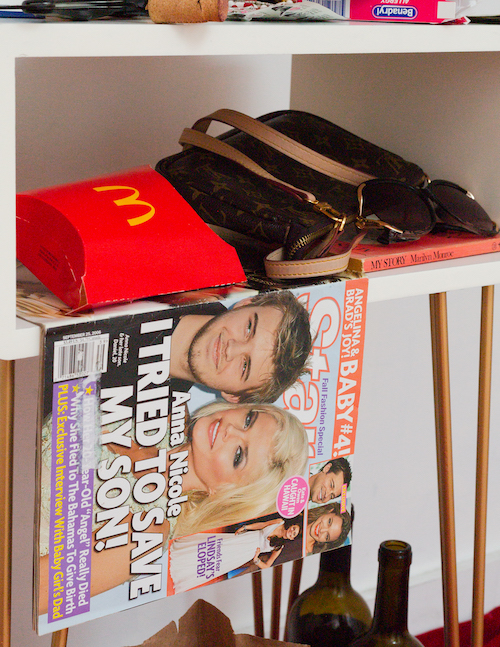
Death and grieving is different for everyone. I have read that our brains do not think about death on a daily basis, but I wonder, after creating this work, if the specter of death is something you think more about these days?
Death and my thinking about death comes in waves. It is a unifying thing despite it being different for everyone – we all deal with it. Again, as a sober person who has seen death at the hands of addiction in my own life, to then see that mirrored in celebrities and pop culture just reinforces that not only does everyone deal with death, but addiction and substance use does not discriminate. It is insidious. That looms over me every day. I have lost people. We have lost artists, musicians, personalities. And it isn’t slowing down. So now, more than ever, substance harm reduction services and education are vital, as is dismantling the stigma around drug use.
Lastly Loverboy is named after the biggest-selling single of 2001, so we always ask what is your favourite Mariah Carey track and why?
Migrate from her genius album E=MC2. It’s quintessential mid-aughts girls night out vibes with T-Pain being the cherry on top. And autotuning Mariah is psychotic and I’m obsessed. Those insane whistle tones are the way the entire album starts and it’s so brilliant and then they transform into the synth line. Music history!
For more on Steven Harwick see @schmuck.everlasting, boundleatherzine.com, and stevenharwick.com
To see images from “Hollywood Forever” visit @other.subjects or killer-dentist.com
Steven Harwick spoke to Killer Dentist for Loverboy







